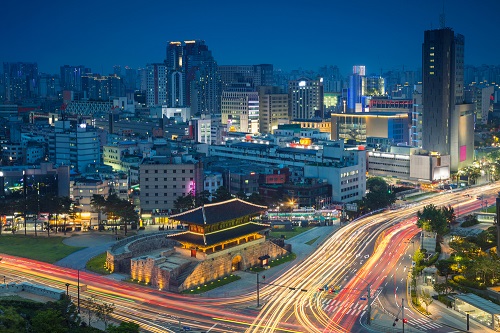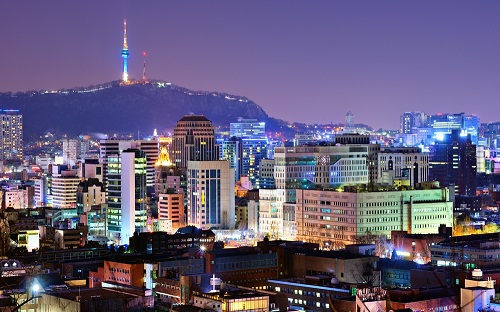Note: This article assumes a normal state of affairs and cannot predict future developments concerning the COVID-19 coronavirus. As long as the coronavirus crisis continues, always check official government guidance before travelling.
In South Korea, the price you will pay for prenatal care, delivery, and postnatal care will depend on a number of factors. For example, are you covered by the national health insurance (NHI) scheme? Do you wish to use a public or a private facility? And what type of delivery would you like? Read on to learn more about your options.
Prenatal
To tackle its declining birth rate, the South Korean government offers bonuses of up to 500,000 won (£330) towards prenatal expenses. Parents receive a monthly allowance of 200,000 won (£130) for the first year of their first child’s life. The amount increases with each subsequent child.
Pregnancy test kits are available at all pharmacies, but you will usually have to ask for one, as they are not put on display.
We recommend vaccinations against the following diseases, if you are actively planning a pregnancy:
- Rubella – this can cause deformities in the baby
- Hepatitis B – this can be passed on to the baby from the mother
- Zika virus – this can cause neurological defects in the baby
If you are not planning a pregnancy but are in a relationship that might lead to one, we would still recommend getting these vaccinations.
You will find plenty of childbirth classes in South Korea, especially in the Seoul area. Korean fathers do not usually attend prenatal classes.
Prenatal visits are usually once a month up to 24 weeks. After that, they become more frequent. From the 36th week, they may be weekly. Expectant mothers will receive ultrasound check-ups on the foetus, blood tests for illnesses likely to harm mother or child, and urine analysis to test for diabetes and UTIs. Pregnant women with Rh-negative blood will be injected with Rh immune globulin at 28 weeks.
It is helpful to identify where you will receive your prenatal care, as well as where you will deliver your baby, as soon as possible. Don’t be afraid to shop around, as there is plenty of choice.

Local medical centres are available in every district. Costs in these are low, often free, and there is a good chance that you will find English-speaking staff. They will provide prenatal care, including all the vaccinations, tests and other treatments you require. However, you will need to make other arrangements for the actual delivery.
There are plenty of specialised maternity clinics that will take care of the whole process, and these are also covered by the NHI scheme. Almost every major university has an affiliated hospital. Privately owned hospitals and international clinics are widely available but are generally the most expensive options. A list of hospitals in South Korea that support natural childbirth can be found on this website.
The NHI scheme subjects all birthing facilities to the same pricing standards, but there may be extra charges for additional services, such as the use of a birthing pool, individual rooms, Western meals, extra nights and medication. Some, but not all, hospitals make birthing pools available for labour and delivery.
Confirm whether the doctor who treats you during your pregnancy will be the one who delivers the baby. If you are in the NHI scheme, then you will need a referral from your family doctor to get an OB-GYN specialist. Once you have chosen a doctor to oversee the birth, you will give birth in the hospital they are associated with, so visit this in advance to make sure that you will be comfortable there.
Whatever your birth plan, you must make sure, well in advance, that your doctor and your facility can meet your needs. Start asking questions at your first meeting, and do not let a question go unanswered, however awkward you may feel pushing for confirmation. Many medical facilities have English-speaking staff or employ specific translators. You may be able to take a friend who can help translate with you. This may be a good idea, as there is quite an extensive amount of paperwork, which will be in Korean.
C-sections are popular in South Korea – around 35% of deliveries use this method. You need to make it clear in advance whether you would prefer a C-section or a vaginal delivery. Note that fathers are not usually allowed to attend C-section deliveries.
Giving birth
You may want to find your own midwife. You can do this through your local medical centre or the Medical Referral Service in the Seoul area (email medicalreferral@seoul.go.kr). Korean women will also often hire a doula – a trained childbirth assistant who supports a woman and her partner through pregnancy and birth and into early parenthood, acting both as a trained professional and as a friend.
Epidurals are common in South Korea, as are episiotomies. If you do not want the latter, you will need to make this very clear. Korean medicine is traditionally very paternalistic, with patients – especially female patients – expected to obey the doctor’s orders and not question anything too closely. Facilities with more experience of Western patients will be more tolerant about following Western practices and meeting Western expectations. If this is important to you, then you should look for a hospital with an International Health Department.
 Note that some doctors, even in international facilities, may prefer to only address the father-to-be. Fathers are usually allowed into the delivery room, but some may still be expected to wait outside. Confirm this in advance.
Note that some doctors, even in international facilities, may prefer to only address the father-to-be. Fathers are usually allowed into the delivery room, but some may still be expected to wait outside. Confirm this in advance.
Although South Korean hospitals are as high-standard as Western ones, practices may be very different. There is often very little privacy, even in the more expensive private hospitals, and births are not always done in a private room, although private rooms are still available for an extra charge. Confirm in advance exactly where you will be giving birth. Before going in to deliver your baby, you should be given a list of items that you will be expected to provide yourself, such as towels, soap and sanitary pads.
Postnatal
The postpartum period is called Samchilil, literally meaning ‘21 days’. It is a period in which mothers are expected to rest. The Western concept of going quickly back to work is unusual.
New mothers typically stay in hospital for three to five days following an uncomplicated vaginal delivery. Following a C-section, they may stay for seven to 10 days. Most hospitals will allow the baby to stay in the room with the mother, though some hospitals will keep the baby in the nursery for the first 24 hours. Confirm this in advance. C-section babies are often kept apart from the mother and other babies for a while, so that their condition can be monitored, though short visits may be allowed for breastfeeding.
Breastfeeding is usually allowed immediately, but some facilities may feed the baby with formula while waiting for the mother’s milk supply to increase.
New mothers traditionally eat a lot of seaweed soup (myuk-guk), and this may be served to you while you’re in the hospital.
Six out of 10 Korean mothers use a postnatal facility. They can be run by hospitals or independently. The more expensive ones resemble a hotel or a health spa, and the mother may stay for one or two months.
Once the family is back home, it is usual for the mother’s mother to live with them. Bear this in mind if you are one half of a cross-cultural relationship.
The South Korean government runs a National Immunisation Programme. Children should receive 22 vaccinations for 14 preventable diseases before they are 12.

